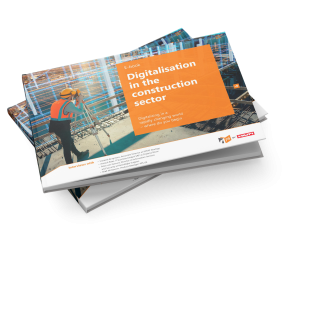

No Illusions: A Grounded View of Digitalisation in UK Construction
At 4PS, we help the construction and civil engineering industry modernise through digital solutions. But transformation isn’t just about tools — it’s about mindset, structure, and timing. We spoke with Bill Palmer, Managing Director at CSXO, who shares a candid and pragmatic view on digitalisation in UK construction — and what needs to happen next. Read on for his insights.
At 4PS, we’re deeply embedded in the construction and civil engineering space, helping companies modernise and streamline through digital solutions. But digital transformation isn’t just about tools. It’s about mindset, structure, and timing.
To explore this further, we spoke with Bill Palmer, Managing Director at CSXO – A successful and highly regarded independent consultancy, specialising in the improvement of processes, systems, and compliance, known for its impartiality and expertise. Bill’s perspective is candid, pragmatic, and refreshingly direct. Below, we share his take on the state of digitalisation in UK construction — and what needs to happen next.
A Sector Divided on Digital Adoption
“The construction market covers a lot of ground so has to be segmented in some way to even attempt to answer this question.”
According to Bill, digital adoption varies widely depending on the size and nature of the business. Tier 1 enterprises, while expressing interest in AI and other technologies, remain reluctant to invest without overwhelming evidence of value. Many are still recovering from overspending on transformation efforts that lacked clarity and measurable outcomes.
“They will hold back until the business case is not only overwhelming but also that there is a clear and present threat in the form of smaller and more agile competitors.”
Meanwhile, the mid-market is where meaningful change is happening.
“It is in the mid-market that we are seeing innovation and adoption at some pace, albeit still not as fast as in other market sectors.”
One area which presents a significant opportunity is in subcontractor management. Bill predicts a shift towards a “keiretsu-style” model, where close, long-term collaboration with selected subcontractors becomes the norm, enabled by digital platforms that drive interoperability and control.
What’s Really Driving Transformation?
“At board level, the drivers are the same as always, and not specific to digital transformation:
- Don’t go to jail
- Don’t be fined, personally or corporately
- Keep your job
- Deliver shareholder value”
According to Bill, compliance with regulation remains the most powerful motivator. While sustainability and cost-efficiency matter, many firms are waiting to act until more certainty – or competitive pressure – forces the issue.
“Sustainability is not going to go away, but it is changing and is therefore a moving target… Shareholder demands will always trump client demands.”
Barriers: Why Change is So Hard
Several key challenges continue to hinder digital transformation across the industry. While the appetite for change is growing, many organisations still encounter significant barriers that prevent progress:
- Cost of entry – The upfront investment required for digital tools, infrastructure, and training can be daunting, particularly for firms with tight margins or competing priorities. Without a clear and immediate return on investment, many hesitate to commit.
- Ignorance and arrogance – In some cases, decision-makers underestimate the complexity of digital transformation or overestimate their organisation’s readiness. This can lead to resistance, misalignment, or underinvestment in critical areas.
- Lack of self-awareness– Businesses often struggle to honestly assess their current capabilities, internal processes, or cultural readiness for change. Without this clarity, transformation efforts can lack focus or direction.
- Immaturity of some offerings (e.g. AI) – While technologies like AI and automation are full of promise, many solutions are still evolving. Some tools are not yet robust enough to deliver consistent value, particularly in complex or fragmented environments, such as construction.
There’s a clear call here for more realism and readiness before embarking on transformation journeys. Success depends not just on technology, but on a grounded understanding of the organisation’s starting point — and a willingness to learn, adapt, and invest at the right pace.
Where the Value Lies
When it comes to identifying technologies with the greatest potential, Artificial Intelligence, particularly large language models (LLMs), stands out as a transformative force. These tools offer the ability to process and analyse vast amounts of data with unprecedented speed and depth.
“The use of large language models to enable more sophisticated data analysis at speed and at scale will be a major game changer… The tools are there but the applications and use cases are still catching up.”
Although the technology is already available, its practical application in construction is still in development. The real value lies not just in the tools themselves, but in how they’re used – turning raw data into actionable insight, improving forecasting, risk management, and strategic planning to drive improvements in margin.
Unlocking that value, however, requires more than just bolt-on “adoption”. It calls for critical thinking, data literacy, and a clear understanding of business needs. Organisations that succeed will be those that not only implement AI but also develop alongside the tool itself the capability to ask the right questions, interpret the results, and apply them meaningfully to decision-making.
Avoiding Common Digital Traps
There are also familiar mistakes that companies make at the start of their digital journey. As Bill puts it:
“Failure to recognise and understand that a digital transformation programme is not a construction project and cannot be treated as such…”
Other common traps include:
- Failing to define a transformation journey via a Target Operating Model (“TOM”)
- Poor or non-existent communication with internal and external stakeholders
- Not learning from past failures — their own or others’
This is a strong reminder that digital transformation is as much about culture and leadership as it is about technology. Success doesn’t come from simply introducing new tools; it requires a shift in mindset, a willingness to challenge established ways of working, and strong leadership to guide people through change. Without a clear vision, effective communication, and genuine buy-in at all levels of the organisation, even the most advanced digital solutions will struggle to deliver lasting value.
What’s Next: AI, Automation, and Acceleration
Looking ahead, Bill predicts that the mid-market, not the Tier 1s, will lead in adoption of new tools and methods.
“They are fast followers at best… The drive won’t come from the Tier 1 enterprises.”
Expect to see more momentum behind modular builds, digital twins, and frictionless procurement. Large, complex projects — from nuclear facilities to data centres — will be key drivers of this shift, with subcontractors under increasing pressure to digitise or risk being left behind.
Digitalisation and Sustainability: An Enabler, Not a Driver
While digital tools are essential for tracking and reporting on sustainability goals, they are unlikely to be the primary reason firms adopt digital solutions.
“It won’t be a driver, however, merely an enabler to gather and present information and to gain insights from it.”
Regulatory reporting will continue to push companies towards better data practices, but sustainability itself isn’t yet the core catalyst for change.
A Final Word of Advice
To conclude, we asked Bill what advice he would give to businesses starting to take digital transformation seriously. His response?
“Be a fast follower, not a leader; learn from the experiences of others, particularly outside of your own industry. Don’t spend without being clear on what you are getting for the money and what you actually need in the future.”
At 4PS, we believe this is excellent advice! The most successful digital journeys start not with hype, but with clarity, curiosity, and a clear business case.
In Conclusion
The construction sector is on the brink of a digital shift, but not in the way many assume. It’s not being led by flashy tech or bold bets from the top. Instead, it’s unfolding in more measured, strategic ways, driven by mid-sized firms, competitive necessity, and pragmatic compliance.
At 4PS, we’re here to support that journey. Whether you’re a cautious fast follower or ready to scale an early-stage investment, our solutions are designed to meet construction businesses where they are and take them where they need to go.
Contributor
Bill Palmer is a seasoned senior executive with more than three decades of experience in business and in leadership roles in both Systems Integrators and Independent Software Vendors. Bill has wide market knowledge, with particular expertise in the Energy and Utilities, Telco, Media, Retail and Construction sectors. Bill’s twin passions are Customer Experience and User Adoption; he firmly believes that both are key to the success of any enterprise.

eBook: Digitalisation in the Construction Sector
Would you like to know more about the developments surrounding digitisation in the construction sector? Or are you curious how other companies are dealing with this? Download our eBook and prepare yourself for the future.
-
Share:
